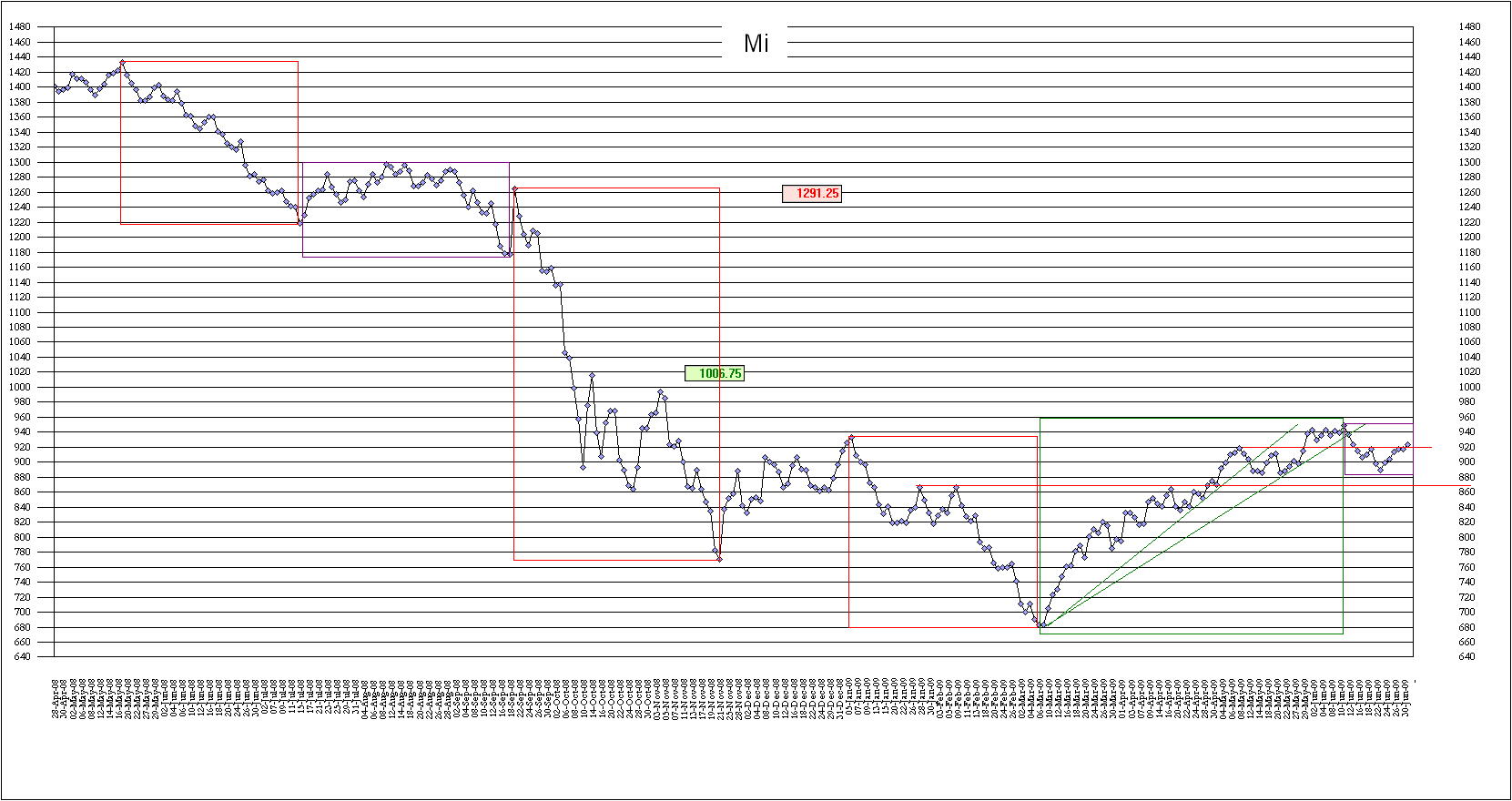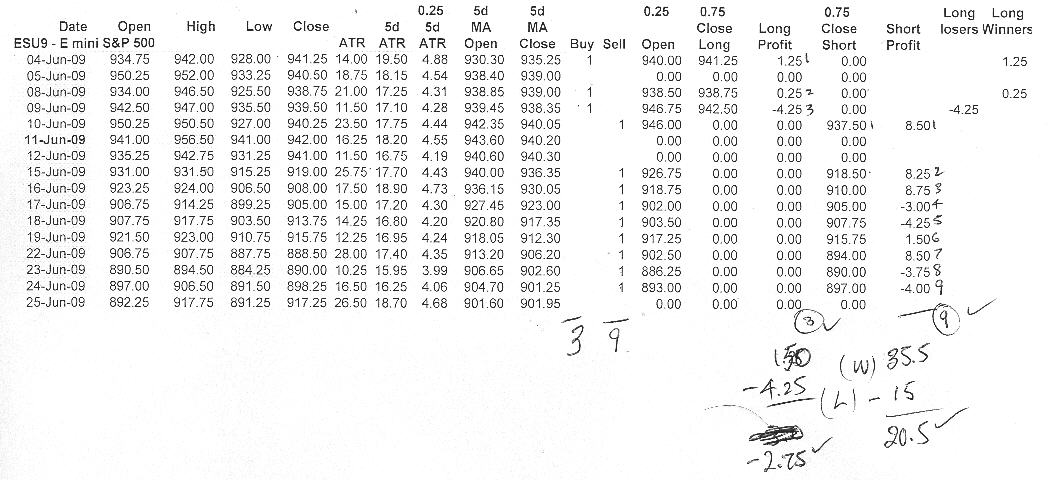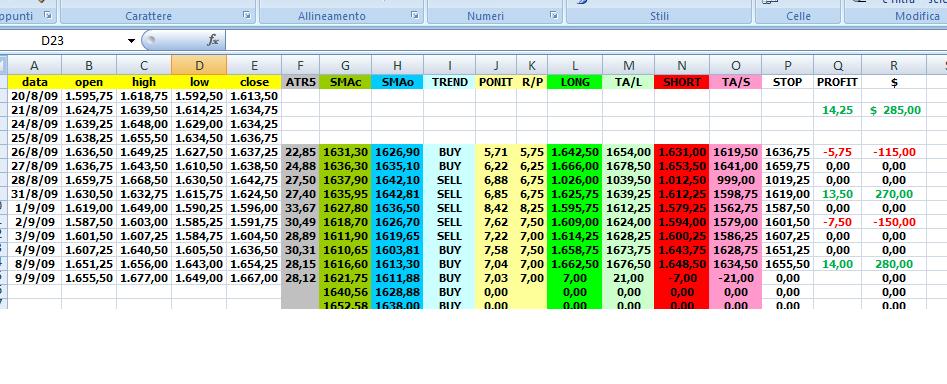2 to 1
Wanted to offer the following in the hope that others might review with a constructive eye and, perhaps, conduct additonal backtesting. My technical abilities are limited, so I backtest manually.
The results for the 28 trading days between Apr 2 - May 12 on NQ June show 19 trades. 13 W 164 points 5L 29.75 points 1 BE. Gross of 134.25 points - $2685 before commission
Methodology
Chart set up: On a day session chart plot the 5 period average true range. Also plot a 5 period simple moving average of both the close and the open. Longs are taken only when the 5 period SMA of the close is above the 5 period SMA of the open. Shorts only when below.
Entries and Exits: If taking longs, add 50% of yesterday's ATR to today's open. This is the entry. Exits are either - a stop order at today's open, limit order at 50% of yesterday's ATR added to today's open, or MOC. For shorts simply reverse.
Having a target that is twice the stop really helped when I manually tested this for the same period as above on the 10 yr note (ZN June). 18 trades were taken. 8 W 83.5 points 10 L 47.5 points Gross of 36.5 points - $1140.62 before commission.
Thanks in advance for your constructive ideas for improvement and any additional backtesting you might undertake.
edit - 25% atr changed to 50%
The results for the 28 trading days between Apr 2 - May 12 on NQ June show 19 trades. 13 W 164 points 5L 29.75 points 1 BE. Gross of 134.25 points - $2685 before commission
Methodology
Chart set up: On a day session chart plot the 5 period average true range. Also plot a 5 period simple moving average of both the close and the open. Longs are taken only when the 5 period SMA of the close is above the 5 period SMA of the open. Shorts only when below.
Entries and Exits: If taking longs, add 50% of yesterday's ATR to today's open. This is the entry. Exits are either - a stop order at today's open, limit order at 50% of yesterday's ATR added to today's open, or MOC. For shorts simply reverse.
Having a target that is twice the stop really helped when I manually tested this for the same period as above on the 10 yr note (ZN June). 18 trades were taken. 8 W 83.5 points 10 L 47.5 points Gross of 36.5 points - $1140.62 before commission.
Thanks in advance for your constructive ideas for improvement and any additional backtesting you might undertake.
edit - 25% atr changed to 50%
So right now I have us in a sideways trend (since about the 4th of June). We would be in a downtrend if/when we get below 880 for a couple of days.
Do you only take longs in uptrends and shorts in downtrends? If so, what do you do in sideways?
quote:
Originally posted by blue
quote:
Originally posted by PaulR
HI Blue:
I'm travelling 'till next week and won't have a chance to review your results in detail until then. WOW...YOU'VE DONE LOTS OF WORK HERE!
1. I do see however that you don't show number of winning trsdes VS losers, just totals.
1b. Also how do you define sideways markets as opposed to rising/falling?
2. Am I reading this right...in June you show 16 Long Trades 9 short trades for a net of 18 points? I assume this is ES.
Will check in again soon as I can.
Best,
Paul
Hi Paul,
I noticed a typo on the headers of my columns on the right. "downtrend/profit trades" and "uptrend profit trades" I reversed, but I think you figured this out.
Re2. Yes, that's right if you mean 4 June to 25 June.
Re1. No I didn't show winners and losers (I have one column for profit). If it's important to you I could add some columns to compute that. I really was more interested in looking at the overall profit picture and trying to maximize that.
RE1b. Uptrend, sideways and downtrend were determined by me with trendlines - which is what I use. I wanted to see where your system was most profitable. I attach a picture.
Take care,
blue
Hi Paul,
Re point 2
argh! I see what you mean!
You are right. I made a mistake on the count.
I had been using the count on the profit column and
didn't notice that when I amended the formula to round to 0.25
it filled it with 0.0 and counted them.
So, I'll fix it and repost the amended as soon as I can.
Re point 2
argh! I see what you mean!
You are right. I made a mistake on the count.
I had been using the count on the profit column and
didn't notice that when I amended the formula to round to 0.25
it filled it with 0.0 and counted them.
So, I'll fix it and repost the amended as soon as I can.
quote:
Originally posted by PaulR
Do you only take longs in uptrends and shorts in downtrends? If so, what do you do in sideways?
Hi Paul,
For this backtest I followed your rules. So therefore whether it was an uptrend, sideways or down, was not applied to the testings. The reason I segmented results is to try to see how the results differed in different areas.
blue
Hi Paul,
One of your posts mentioned s. th like
"when I find one of these things it works for a while and then falls apart" and you asked about improvements.
---------
Here are my intial thoughts on a system and tesing it.
First I ask
"What is this system trying to capture?"
"What is the statement or hypothesis?"
Using your system as an example, the general phasing of it might be s. th like:
In a "down day" if the price falls below x then short and close the short at y.
If it doesn't get to y stop yourself out at z or the day's close.
So we have:
"down day"
x
y
z
I was thinking about the definition of "down day"
A. The most usual is when today's close is < yest close.
B. Another might be today's midpoint < yesterday's midpoint.
C. But for your system we mean a day when
the low < the open (by a good margin).
So the first thing I would look at is our rule for "down day"
effective at identifying "C". In other words is
MA Close - MA Open a good predictor of when
the low will be less than the open by enough to get to y.
(and without a "nessie stop out")
(A "nessie stop out" would be price falls to our trigger x and then rises to our
stop-loss z before falling to y.
With numbers:
25%of MA atr at 4points, Open= 915
x= 915-4=912
y=915-8 = 907
z= 915+4 = 916
So a nessie stop out is opening at 915, falling to 912 or less but not as far as 907,
climbing back to 916 where we stop out and then falling to 907 where we would have
taken a profit if we had of still been in the trade.)
So is MA close vs MA open effective at identifying "C" type down days?
We are going to short (and not going to go long based on it).
It would seem to me that:
1. In strong down periods you want to short every day.
2. The best price to short is probably the open or above the open
3. The best price to close is the low of the day
- since you don't know what the low is you could estimate with the average daily range
subtracted from the high. When you get there you can close or use a trailing stop or
stay with it until an indicator shows the end of the fall.
So for a downtrend we would look at the average amt the high is above the open.
If this is very little eg less than 4 points on a average 25 point range {@abs(h-l)} then we
would just sell at open. If not, then we can find tune our sell price to the average above open
and then when you get or use a trailing buy or
stay with it until an indicator shows the end of the rise.
All of this is if you want to have only a day trade.
Just some ideas.
blue
One of your posts mentioned s. th like
"when I find one of these things it works for a while and then falls apart" and you asked about improvements.
---------
Here are my intial thoughts on a system and tesing it.
First I ask
"What is this system trying to capture?"
"What is the statement or hypothesis?"
Using your system as an example, the general phasing of it might be s. th like:
In a "down day" if the price falls below x then short and close the short at y.
If it doesn't get to y stop yourself out at z or the day's close.
So we have:
"down day"
x
y
z
I was thinking about the definition of "down day"
A. The most usual is when today's close is < yest close.
B. Another might be today's midpoint < yesterday's midpoint.
C. But for your system we mean a day when
the low < the open (by a good margin).
So the first thing I would look at is our rule for "down day"
effective at identifying "C". In other words is
MA Close - MA Open a good predictor of when
the low will be less than the open by enough to get to y.
(and without a "nessie stop out")
(A "nessie stop out" would be price falls to our trigger x and then rises to our
stop-loss z before falling to y.
With numbers:
25%of MA atr at 4points, Open= 915
x= 915-4=912
y=915-8 = 907
z= 915+4 = 916
So a nessie stop out is opening at 915, falling to 912 or less but not as far as 907,
climbing back to 916 where we stop out and then falling to 907 where we would have
taken a profit if we had of still been in the trade.)
So is MA close vs MA open effective at identifying "C" type down days?
We are going to short (and not going to go long based on it).
It would seem to me that:
1. In strong down periods you want to short every day.
2. The best price to short is probably the open or above the open
3. The best price to close is the low of the day
- since you don't know what the low is you could estimate with the average daily range
subtracted from the high. When you get there you can close or use a trailing stop or
stay with it until an indicator shows the end of the fall.
So for a downtrend we would look at the average amt the high is above the open.
If this is very little eg less than 4 points on a average 25 point range {@abs(h-l)} then we
would just sell at open. If not, then we can find tune our sell price to the average above open
and then when you get or use a trailing buy or
stay with it until an indicator shows the end of the rise.
All of this is if you want to have only a day trade.
Just some ideas.
blue
You wanted Winners and losers and I cut off the headers in the above.
So 33 long side losers for -246
44 long side winners for +347
So 42 short side losers for -287
59 short side winners for +789
3 trades with zero profit.
So 33 long side losers for -246
44 long side winners for +347
So 42 short side losers for -287
59 short side winners for +789
3 trades with zero profit.
I have built some overly complex systems since I started studying and day-trading the ES. The other day I wrote in my notebook "some days don't worry about the high or low estimates - just sell"
----------
From a book called "sniper trading":
"As luck would have it, one younger version of these mentors materialized at the moment when Iwas having serious doubts about my ability to make a living trading. Realizing I was struggling, he offered guidance over a cup of coffee one 'afternoon across the street from the exchal1ge.
"Look," he said to me after a particularly tumultuous day in the pit. "I see you in there buying the highs and s~~ling the lows. You are not going to last long down here doing that." Then he took out a trading card and placed it on the counter. "Here's the only way I can lose," he explained, drawing a volatile market that whipsawed back and forth. It was the classic searchand-destroy day pattern with rising tops and lower bottoms. "Fortunately,
this doesn't happen every day. Instead, you usually get some sort of trend off the open-either up or down. If I'm wrong, I double-up and reverse.
~
Even if you lose ten ticks on one, you only need five ticks on the reversal to
get even."
"But what about the money?" I asked.
"Don't think about the money," he said. "Just do it."
The first time I had to double-up and reverse, I was terrified. But it
worked. After that, we became good friends and I often sought his advice.
"How do you know the direction?" I asked him one day when we were
having one of our end-of-day coffee sessions.
"You don't. That's why you see me standing there at the open watching all the confusion. I wait until the market tells me a direction and then I wait for a pullback and load the boat."
"And then-getting out" I asked.
"If I get a pop or a break," he said, "I take profits. You have to take those
profits." He said this as if it were the most natural thing in the world." p12
----------
From a book called "sniper trading":
"As luck would have it, one younger version of these mentors materialized at the moment when Iwas having serious doubts about my ability to make a living trading. Realizing I was struggling, he offered guidance over a cup of coffee one 'afternoon across the street from the exchal1ge.
"Look," he said to me after a particularly tumultuous day in the pit. "I see you in there buying the highs and s~~ling the lows. You are not going to last long down here doing that." Then he took out a trading card and placed it on the counter. "Here's the only way I can lose," he explained, drawing a volatile market that whipsawed back and forth. It was the classic searchand-destroy day pattern with rising tops and lower bottoms. "Fortunately,
this doesn't happen every day. Instead, you usually get some sort of trend off the open-either up or down. If I'm wrong, I double-up and reverse.
~
Even if you lose ten ticks on one, you only need five ticks on the reversal to
get even."
"But what about the money?" I asked.
"Don't think about the money," he said. "Just do it."
The first time I had to double-up and reverse, I was terrified. But it
worked. After that, we became good friends and I often sought his advice.
"How do you know the direction?" I asked him one day when we were
having one of our end-of-day coffee sessions.
"You don't. That's why you see me standing there at the open watching all the confusion. I wait until the market tells me a direction and then I wait for a pullback and load the boat."
"And then-getting out" I asked.
"If I get a pop or a break," he said, "I take profits. You have to take those
profits." He said this as if it were the most natural thing in the world." p12
quote:
Originally posted by PAUL9
that's OK daytrading, I just have to make a few more posts. But when I saw that RUSS had 9 I wondered, how many do you need?
hi,
you please check if my levels are correct?
Emini Day Trading /
Daily Notes /
Forecast /
Economic Events /
Search /
Terms and Conditions /
Disclaimer /
Books /
Online Books /
Site Map /
Contact /
Privacy Policy /
Links /
About /
Day Trading Forum /
Investment Calculators /
Pivot Point Calculator /
Market Profile Generator /
Fibonacci Calculator /
Mailing List /
Advertise Here /
Articles /
Financial Terms /
Brokers /
Software /
Holidays /
Stock Split Calendar /
Mortgage Calculator /
Donate
Copyright © 2004-2023, MyPivots. All rights reserved.
Copyright © 2004-2023, MyPivots. All rights reserved.




